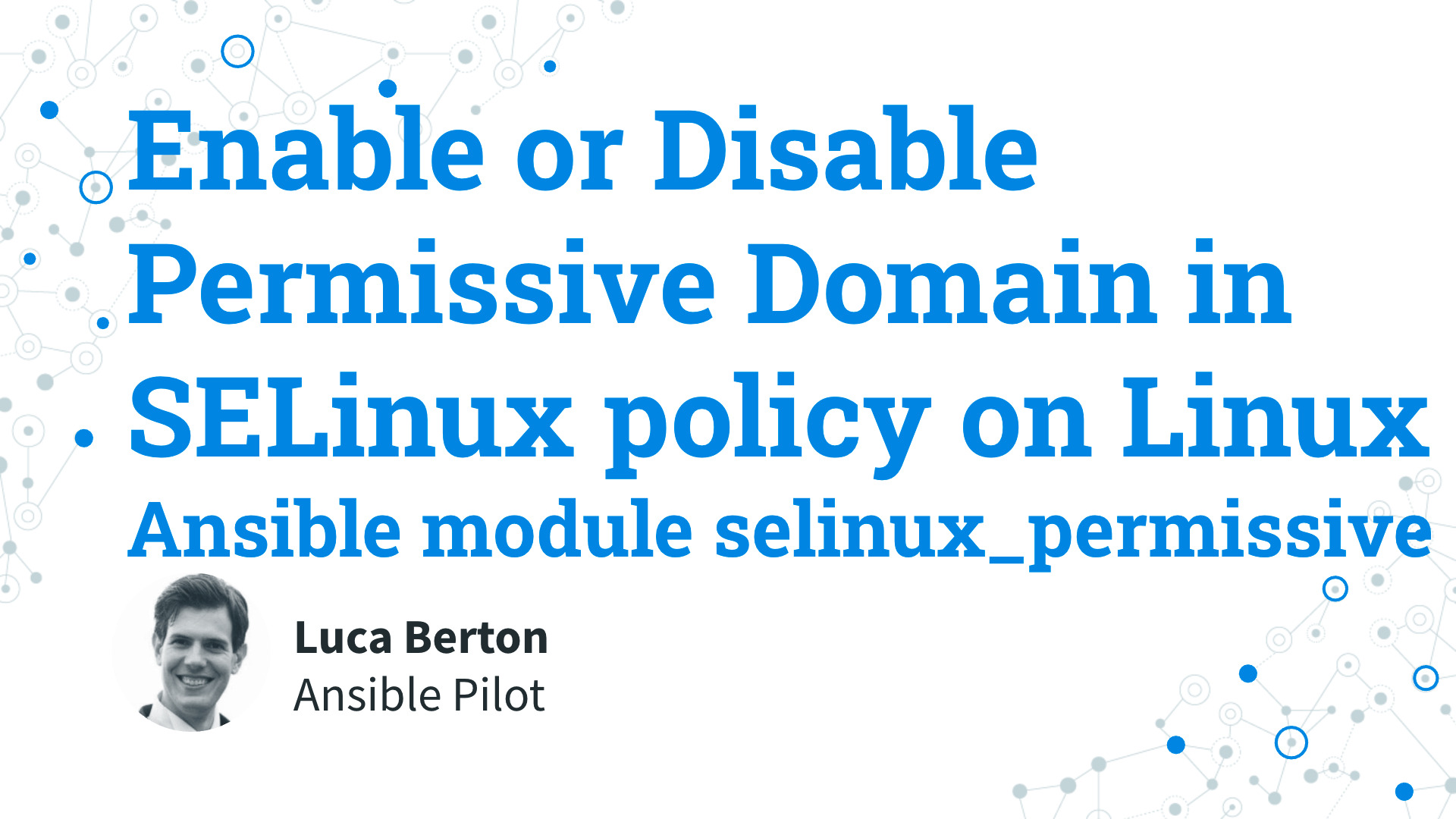SELinux Permissive Domain
What is SELinux?
Security-Enhanced Linux (SELinux) is a Linux kernel security module that provides a mechanism for supporting access control security policies, including mandatory access controls (MAC).
What is SELinux Permissive Domain?
SELinux Permissive Domains allow an administrator to configure a single process (domain) to run permissive, rather than making the whole system permissive.
Ansible Enable or Disable Permissive Domain in SELinux policy
community.general.selinux_permissive- Change permissive domain in SELinux policy
Today we’re talking about Ansible module selinux_permissive.
The full name is community.general.selinux_permissive, which means that is part of the collection of modules to community-supported for Ansible.
It supports a huge variety of Linux distributions and it changes the permissive domain in SELinux policy.
It requires the policycoreutils-python package installed on the target system for semanage utility.
Parameters
- domain (name) string - the name of the domain
- permissive boolean - no/yes
- no_reload boolean - no/yes
Let’s see the parameter of the selinux_permissive Ansible module. The only mandatory parameters are “domain” and “permissive”. The parameter “domain” or alias “name” specifies the name of the SELinux domain that we would add to the list of permissive domains. The parameter “permissive” allows you to enable or disable the SELinux permissive domain immediately in the running system. The parameter “no_reload” disables the policy reloading after a change of the setting. Default is “no”, which causes the reloading of the policy.
Links
- https://docs.ansible.com/ansible/latest/collections/community/general/selinux_permissive_module.html
- https://selinuxproject.org/page/PermissiveDomainRecipe
- https://www.redhat.com/sysadmin/semanage-keep-selinux-enforcing

Playbook
Enable or Disable Permissive Domain in SELinux policy on Linux with Ansible Playbook.
code
---
- name: selinux_permissive module Playbook
hosts: all
become: true
tasks:
- name: semanage present
ansible.builtin.package:
name: "policycoreutils-python-utils"
state: present
- name: Change the httpd_t domain to permissive
community.general.selinux_permissive:
name: httpd_t
permissive: true
execution
$ ansible-playbook -i virtualmachines/demo/inventory selinux/selinux_permissivedomain.yml
PLAY [selinux_permissive module Playbook] *************************************************************
TASK [Gathering Facts] ****************************************************************************
ok: [demo.example.com]
TASK [semanage present] ***************************************************************************
changed: [demo.example.com]
TASK [Change the httpd_t domain to permissive] ****************************************************
changed: [demo.example.com]
PLAY RECAP ****************************************************************************************
demo.example.com : ok=3 changed=2 unreachable=0 failed=0 skipped=0 rescued=0 ignored=0
ansible-pilot $
idempotency
$ ansible-playbook -i virtualmachines/demo/inventory selinux/selinux_permissivedomain.yml
PLAY [selinux_permissive module Playbook] *************************************************************
TASK [Gathering Facts] ****************************************************************************
ok: [demo.example.com]
TASK [semanage present] ***************************************************************************
ok: [demo.example.com]
TASK [Change the httpd_t domain to permissive] ****************************************************
ok: [demo.example.com]
PLAY RECAP ****************************************************************************************
demo.example.com : ok=3 changed=0 unreachable=0 failed=0 skipped=0 rescued=0 ignored=0
ansible-pilot $
before execution
$ ssh [email protected]
[devops@demo ~]$ sudo su
[root@demo devops]# sestatus
SELinux status: enabled
SELinuxfs mount: /sys/fs/selinux
SELinux root directory: /etc/selinux
Loaded policy name: targeted
Current mode: enforcing
Mode from config file: enforcing
Policy MLS status: enabled
Policy deny_unknown status: allowed
Memory protection checking: actual (secure)
Max kernel policy version: 33
[root@demo devops]# semanage permissive -l
bash: semanage: command not found
[root@demo devops]#
after execution
$ ssh [email protected]
[devops@demo ~]$ sudo su
[root@demo devops]# sestatus
SELinux status: enabled
SELinuxfs mount: /sys/fs/selinux
SELinux root directory: /etc/selinux
Loaded policy name: targeted
Current mode: enforcing
Mode from config file: enforcing
Policy MLS status: enabled
Policy deny_unknown status: allowed
Memory protection checking: actual (secure)
Max kernel policy version: 33
[root@demo devops]# semanage permissive -l
Builtin Permissive Types
Customized Permissive Types
httpd_t
[root@demo devops]# reboot
Connection to demo.example.com closed by remote host.
Connection to demo.example.com closed.
ansible-pilot $ ssh [email protected]
[devops@demo ~]$ sudo su
[root@demo devops]# sestatus
SELinux status: enabled
SELinuxfs mount: /sys/fs/selinux
SELinux root directory: /etc/selinux
Loaded policy name: targeted
Current mode: enforcing
Mode from config file: enforcing
Policy MLS status: enabled
Policy deny_unknown status: allowed
Memory protection checking: actual (secure)
Max kernel policy version: 33
[root@demo devops]# semanage permissive -l
Builtin Permissive Types
Customized Permissive Types
httpd_t
[root@demo devops]#
Conclusion
Now you know how to Enable or Disable a Permissive Domain in the SELinux policy on Linux with Ansible. Subscribe to the YouTube channel, Medium, and Website, X (formerly Twitter) to not miss the next episode of the Ansible Pilot.
Academy
Learn the Ansible automation technology with some real-life examples in my
Udemy 300+ Lessons Video Course.

My book Ansible By Examples: 200+ Automation Examples For Linux and Windows System Administrator and DevOps

Donate
Want to keep this project going? Please donate
